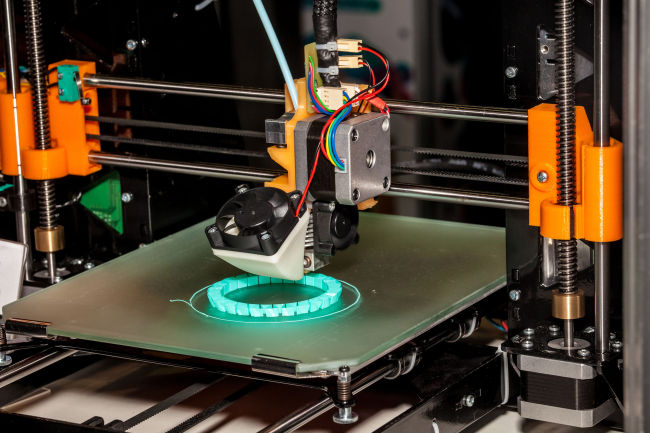[Industry 4.0] ‘Korea’s R&D policy needs overhaul to spur innovation’
By Park Hyung-kiPublished : Aug. 11, 2016 - 16:01
In the 1970s, South Korea’s industrial policy mostly focused on lifting the country out of poverty as it reeled from the aftermath of the Korean War, Japanese colonization and internal political turmoil.
Its policy then concentrated on accelerating growth by handpicking key industries and developing them as rapidly as possible so that Korea could catch up with the advanced economies of the U.S., Europe and Japan.

With its growth-first policy, the country encouraged those industries to research, develop and commercialize technologies mainly through reverse engineering, which basically involved copying products from developed economies and selling them at cheaper prices in domestic and global markets.
The country’s protective policy with this research and development strategy led to the creation of conglomerates and industries that were able to either catch up or surpass their American and Japanese counterparts.
However, this rapid growth until the late 1990s and early 2000s began to show side effects as industrial development and growth did not boost people’s social well-being and happiness.
The traditional flagship industries such as shipbuilding, petrochemical and steel, which used to enjoy stellar growth, have reached their limits in this digital age, with many of them winding down their businesses and manpower amid increasing bad debts.
Although Korea’s R&D investment and spending in proportion to its gross domestic product is one of the highest in the world, analysts say its R&D policy that focuses on boosting growth through conglomerates has become outdated and needs a major overhaul.
The Organization for Economic Cooperation and Development said in a 2015 report that Korea’s R&D policy needs to be retooled so it can spur innovation by promoting small and medium-size enterprises and start-ups.
Asia’s fourth-largest economy currently excels in the R&D of “frontier technologies and applications,” but OECD stressed that Korea’s R&D policy should move away from its focus on conglomerates. It needs to give more weight to small businesses and basic science research by adopting the culture of “open and collaborative innovation” to narrow the productivity gap between big and small companies.
“Business engagement with the research sector is still limited,” the OECD said. “International collaboration can play an important role also in business innovation by allowing firms to gain access to a broader pool of resources and knowledge at lower cost and to share risks.”
In order to overcome rising socioeconomic problems such as rising inequality, the aging population and the low birth rate, Ahn Joong-gi, a researcher at the Hyundai Research Institute said that Korea should also expand its R&D investment in basic science.
Korea has been increasing its R&D in this field following the Ministry of Science, ICT and Future Planning’s commitment to increase its budget for basic science research from about 38 percent of total state R&D in 2013 to over 40 percent by 2017.
Still, most of its basic science and technology R&D are taking place in the private business sector, which accounts for about 60 percent of all basic research, compared to about 50 to 75 percent at higher education in other countries, according to OECD data.
“For Korea to become a ‘first mover’ from a ‘fast follower,’ it needs to continuously invest in basic research for a long period of time, more than in the development of (technology) applications,” said Ahn of Hyundai Research Institute.
The researcher stressed that the only alternative for Korea’s sustainability is an R&D policy promoting technology innovation to overcome the low birth rate, aging society and decreasing labor productivity and capital.
As part of the incumbent administration’s “creative economy policy” that focuses on generating future value and increasing employment, Korea introduced a tax revision, allowing an up to 30 percent deductible rate for small and medium-size enterprises on R&D for one of the 11 next-generation fields.
The 11 sectors include artificial intelligence, content development, health care and robotics.
“Should companies increase their R&D spending in proportion to annual sales, they will enjoy more tax cuts, especially in the development of new drugs (in health care),” the Finance Ministry said in a press statement.
The government will further offer tax deductions of up to 10 percent for small businesses and 7 percent for conglomerates when they increase facility investments for technology commercialization.
By Park Hyong-ki (hkp@heraldcorp.com)
Its policy then concentrated on accelerating growth by handpicking key industries and developing them as rapidly as possible so that Korea could catch up with the advanced economies of the U.S., Europe and Japan.

With its growth-first policy, the country encouraged those industries to research, develop and commercialize technologies mainly through reverse engineering, which basically involved copying products from developed economies and selling them at cheaper prices in domestic and global markets.
The country’s protective policy with this research and development strategy led to the creation of conglomerates and industries that were able to either catch up or surpass their American and Japanese counterparts.
However, this rapid growth until the late 1990s and early 2000s began to show side effects as industrial development and growth did not boost people’s social well-being and happiness.
The traditional flagship industries such as shipbuilding, petrochemical and steel, which used to enjoy stellar growth, have reached their limits in this digital age, with many of them winding down their businesses and manpower amid increasing bad debts.
Although Korea’s R&D investment and spending in proportion to its gross domestic product is one of the highest in the world, analysts say its R&D policy that focuses on boosting growth through conglomerates has become outdated and needs a major overhaul.
The Organization for Economic Cooperation and Development said in a 2015 report that Korea’s R&D policy needs to be retooled so it can spur innovation by promoting small and medium-size enterprises and start-ups.
Asia’s fourth-largest economy currently excels in the R&D of “frontier technologies and applications,” but OECD stressed that Korea’s R&D policy should move away from its focus on conglomerates. It needs to give more weight to small businesses and basic science research by adopting the culture of “open and collaborative innovation” to narrow the productivity gap between big and small companies.
“Business engagement with the research sector is still limited,” the OECD said. “International collaboration can play an important role also in business innovation by allowing firms to gain access to a broader pool of resources and knowledge at lower cost and to share risks.”
In order to overcome rising socioeconomic problems such as rising inequality, the aging population and the low birth rate, Ahn Joong-gi, a researcher at the Hyundai Research Institute said that Korea should also expand its R&D investment in basic science.
Korea has been increasing its R&D in this field following the Ministry of Science, ICT and Future Planning’s commitment to increase its budget for basic science research from about 38 percent of total state R&D in 2013 to over 40 percent by 2017.
Still, most of its basic science and technology R&D are taking place in the private business sector, which accounts for about 60 percent of all basic research, compared to about 50 to 75 percent at higher education in other countries, according to OECD data.
“For Korea to become a ‘first mover’ from a ‘fast follower,’ it needs to continuously invest in basic research for a long period of time, more than in the development of (technology) applications,” said Ahn of Hyundai Research Institute.
The researcher stressed that the only alternative for Korea’s sustainability is an R&D policy promoting technology innovation to overcome the low birth rate, aging society and decreasing labor productivity and capital.
As part of the incumbent administration’s “creative economy policy” that focuses on generating future value and increasing employment, Korea introduced a tax revision, allowing an up to 30 percent deductible rate for small and medium-size enterprises on R&D for one of the 11 next-generation fields.
The 11 sectors include artificial intelligence, content development, health care and robotics.
“Should companies increase their R&D spending in proportion to annual sales, they will enjoy more tax cuts, especially in the development of new drugs (in health care),” the Finance Ministry said in a press statement.
The government will further offer tax deductions of up to 10 percent for small businesses and 7 percent for conglomerates when they increase facility investments for technology commercialization.
By Park Hyong-ki (hkp@heraldcorp.com)









![[Hello India] Hyundai Motor vows to boost 'clean mobility' in India](http://res.heraldm.com/phpwas/restmb_idxmake.php?idx=644&simg=/content/image/2024/04/25/20240425050672_0.jpg&u=)









